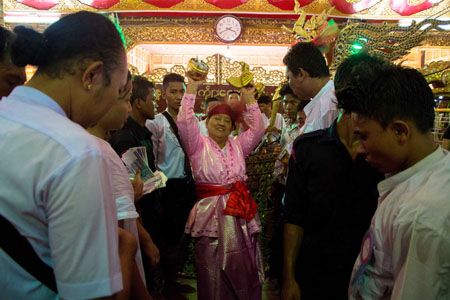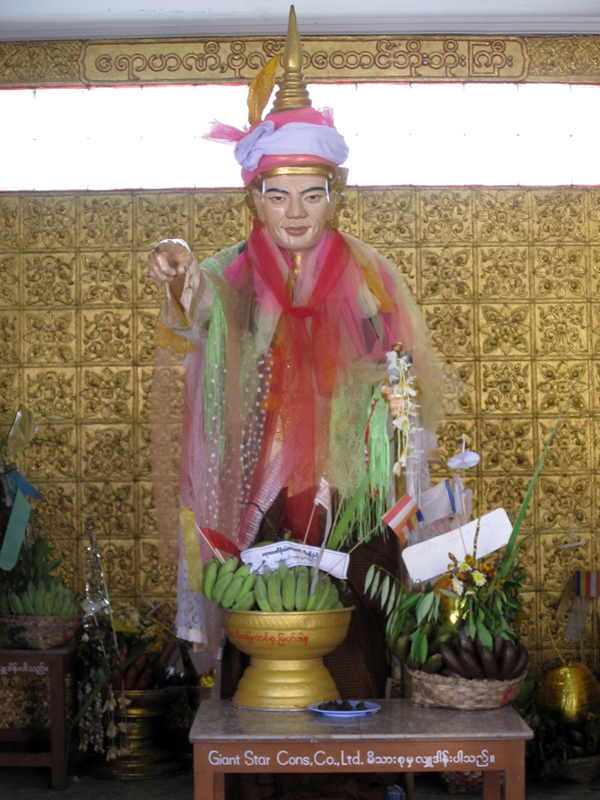Mingun is a truely delightful village that is just visible from the summit of the Mandalay Hill across the expanse of the Irrawaddy River. Ferry boats are numerous during the festival and only charge 1 thounsand kyats to take passengers to the other sides in a journey of less than an hour. Mingun is famous for its colossal unfinished pagoda. It was ambition of King Bodaw Phaya to turn Mingun into the grandest religious sanctuary in the world. Near Mingun the most erudite Sayadaw in Burma lives at Momeik where the famous Tipitaka pagoda was consecrated in 1985.
Equidistant between these two venerable sites, stands the temple of the Prince and Princess of the Golden Teak. The festival takes place from the 5th to 10th day of the waxing moon of Taboung. The legend is related in a little book sold during the festival. The story takes place on the Shweli river between Momeik and another town upstream and in the Shan State also called Momeik. U Hkun Naung was Sawbwa of Hsipaw at the time of King Mindon. His youngest brother fomented a revolt and manage to oust the Sawbwa suddenly. A number of his children perished in the confrontation and the usurper didn’t rest until he’d eliminated all the possible pretenders to the principality of Hsibaw.

As a consolation the deposed sawbwa accepted from king Mindon the governorship of the Momeik township and went there with his two surviving children. Sai TungNaung and his sister Sao Naung Htwe. He returned once again to a pleasant and peaceful existance puncuated by sumptuous festivities on the Shweli river during the hot season. One year as he was suffering from exhaustion the sawbwa couldn’t attend the boat race. His young children ran away from their minders and jumped into a long boat and navigated on the water. The governess gave the alert, but the people engrossed in the entertainments didn’t hear her. With the approach of a menacing storm everybody looked for shelter as the boat drifted away and the river flooded carrying timbers off. One such teak trunk struck their boat and split it into two pieces, the children grabbed the trunk, but drowned by Thit Yait Kyun, the isle where the Teak Hit the log. The loyal governess grabbed another log and went after he children followed by the sawbwa and his Maha Devi. When she despaired of finding her children, their mother died from a broken heart. Her husband had at this place the “Lwam-Ceti” (Pagoda of Despair) built.
Nevertheless the fatal tree ended up landing on a sterile shore, ever since it was known as Kyun Bin Hla (the land of Beautiful Tree). It was then carried off towards the confluence of the Irrawaddy and Shweli rivers. At the village near the Mingun-Thebyu creek the Boe Boe Gyi, the guardian spirit of that locality announced to the children that they were not human anymore but Nats and gave them jurisdiction of 1 2 districts. Obediant to their destiny the new Nats established themselves in a tree rooted to the ungrateful and sandy earth of the river banks. Little by little a Nat-sin developed and a cult formed.
It teaches some strange ideas: no one may approach the teak tree on horseback, couples should not come in fear of snake-bite, and an offering of flowers should be tied to the prow of boats for safe passage. The Nats have thus become the keepers of the river and it is said their power spreads from the Shweli as far south as Bagan. In 1937, Daw San Shwe, the wife of a boatman saw the Prince of the Golden Teak appear. He asked her to build a bigger Nat-sin and also a pagoda. The Japanese occupation and the forced labor of her son to work on Siam-Burma railway made such a donation at such a time quite impossible, however after the war she fulfilled her obligation, from then till now there has been a festival at Mingun.

The sacred tree is still there and flourishes not around March or April as is normal, but in August with its flowers overturned in respect towards the nat-sin. The temple was renewed in 1977 and the pagoda the nats had so wanted was then built. On the 16th August 1985 the festival arrangements were jeopardized by a cholera epidemic in Sagaing area. The town council forbade the gathering through the Taungbyon festival, outside the Sagaing Division’s jurisdiction went ahead. Despite this, on the following day the party was at its pitch before the indulgent eyes of the local police.
That day was dedicated to the ablution of the nats in the river. Due to the government restrictions the bamboo raft had failed to arrive the procession therefore went on foot to a creek at about 2 kilometers away from the temple. The next day was dedicated to a rather unusual ceremony. The nats were placed on 2 swings that were solemnly set in motion. After this short game, the followers rushed to pick up the leaves that ornamented the swings. The swinging ritual was performed outside the temple for the Boe Boe Gyi and then all the nat-kadaw themselves took part in the swinging game.
On the fourth day, the public were allowed to swing and the 5th day was dedicated to taking the nats for a stroll in the garden. On the 6th day a tree, speially cut down for the occation arrived. The last day was dedicated to making offerings to the monks who were not averse to showing themselves.
The proximity of the Irrawaddy River gave the festival an unusual solemnity. The legend that gave it birth has some analogy with the Mahagiri one. Mahagiri perished with his sister through fire and not water, but in both legends they drift on the river on a floating log. During the Burmese monsoon, drifting trees are so common a sight that these stories cannot, but stimulate the popular imagination.
